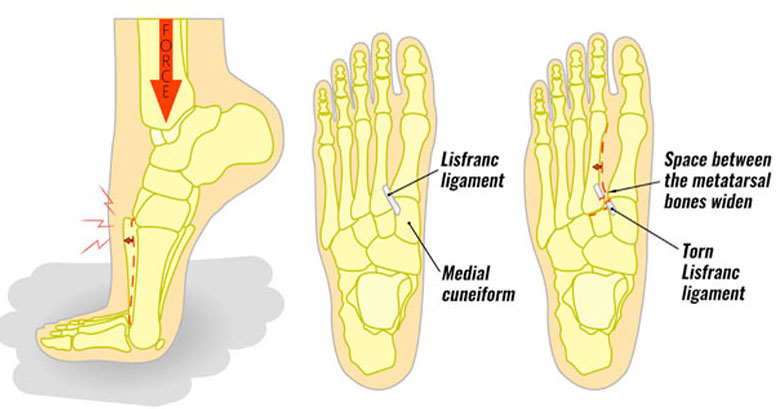A potentially devastating midfoot injury
A Lisfranc injury is considered one of the dreaded conditions you can experience during sports as they can take a lot of time and energy to recover from! If you think you’ve experienced a Lisfranc injury, it’s essential you get it assessed and treated as quickly as possible. In this blog, I’ll outline all the information you need so you can get on top of your injury as soon as possible!
What is a Lisfranc Injury?
A lisfranc complex refers to the area of your foot that connects your midfoot to your forefoot. The larger ‘lisfranc ligament’ and surrounding smaller ligaments provide stability for the many bones in the midfoot, as well as the long metatarsals of the forefoot. If one of these bones or ligaments is injured, you will lose the ability to be able to stabilise the middle of your foot, which is a problem for those of us who are quite active!
How to Assess a Lisfranc Injury?
There are three stages of a lisfranc injury:
- Stage 1: A sprain of the lisfranc ligament with no visible separation between the 1st and 2nd toes.
- Stage 2: A rupture of the lisfranc ligament with mild visible separation between the 1st and 2nd toes.
- Stage 3: A rupture of the lisfranc ligament and more than 5mm of separation between the 1st and 2nd toes.
Our podiatrists will run through a number of assessments and will utilise foot imaging to be sure of an accurate diagnosis.
What are the Signs & Symptoms of a Lisfranc Sprain?
You may notice a number of symptoms for a lisfranc injury, including:
- Pain at the top of the forefoot.
- Bruising and swelling throughout the midfoot.
- Pain worsens on weightbearing, particularly when toeing-off whilst walking.
- A feeling of instability whilst walking.
How to Treat a Lisfranc Injury?
If you suspect a lisfranc injury, it will be essential to have it assessed by a podiatrist as soon as possible. As well as conducting a number of assessments, we will refer you for either an Xray, CT or MRI scan to confirm the diagnosis. After we have accurately diagnosed the injury/ severity, we will go through a treatment plan which may include:
- CAM boot/ moon boot to offload the area and allow the lisfranc ligament to heal.
- Padding and strapping for minor cases to provide short term offloading.
- Orthotics as a long term solution to allow adequate offloading of midfoot.
Referral for surgery: if the Lisfranc ligament has ruptured, surgery will be required to repair the joint and provide long term stability.
How NOT to treat a Midfoot Sprain
One of the worst ways to go about managing a Lisfranc Injury is by just pushing through the pain! With continued loading comes continued stress, and it may regress to the point that surgery is the only option. Getting your foot checked might save you suffering months down the track!
If you think you might be struggling with a lisfranc injury, be sure to book an appointment with The Movement Centre today.
Our podiatrists strive to provide expert level care of all conditions of the foot and lower leg and would love to get you back on your feet pain free!



